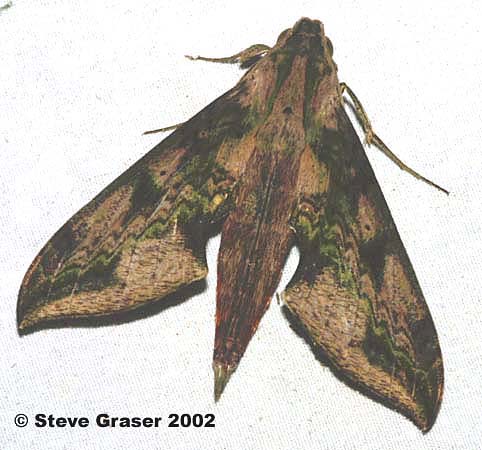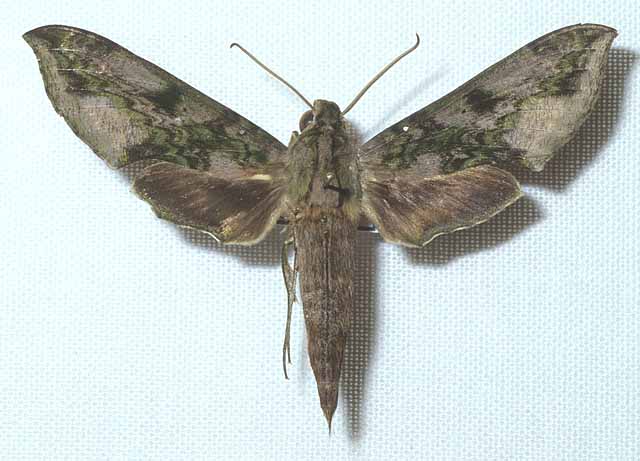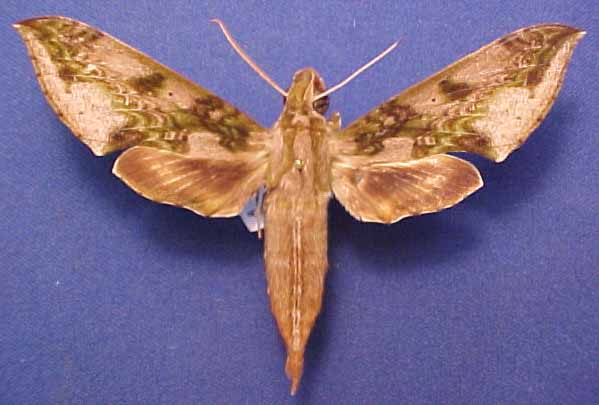Xylophanes fusimacula
Xylophanes fusimacula
zail-AH-fan-eesmmfew-sih-MAGH-kque-luh
(R. Felder, [1874])
Pergesa

Xylophanes fusimacula courtesy of Steve Graser.
Yasuni, Ecuador, September 7, 2002 - 2:06 AM
This site has been created by
Bill Oehlke at oehlkew@islandtelecom.com
Comments, suggestions and/or additional information are welcomed by Bill.
TAXONOMY:
Family: Sphingidae, Latreille, 1802
Subfamily: Macroglossinae, Harris, 1839
Tribe: Macroglossini, Harris, 1839
Genus: Xylophanes Hubner [1819] ...........
Species: fusimacula R. Felder, 1874
|
MIDI MUSIC
.....It's a Wonderful World.....
copyright C. Odenkirk
ON.OFF
<bgsound src="world.mid" LOOP=FOREVER>
|
DISTRIBUTION:
Xylophanes fusimacula moths
fly from Brazil to Colombia and
Bolivia: Beni: Yacuma (300-800m).
Xylophanes niepelti Gehlen, 1922, Colombia, is the same as
Xylophanes fusimacula.

Xylophanes fusimacula male, courtesy of Hubert Mayer
copyright.
Similar in colour and pattern to Xylophanes undata and Xylophanes zurcheri but immediately distinguished by the entire
(not crenulated) outer margin of the forewing.
Forewing outer margin entire, slightly excavated below apex.
Forewing upperside similar in colour and pattern to that of Xylophanes undata and Xylophanes zurcheri but first, second and fourth postmedian lines
conspicuous, strongly crenulated and more oblique, delineating a narrow, rectangular, pale purple-grey patch that stretches from the tornus to just beyond M3.
CATE
The pronunciation of scientific names is
troublesome for many. The "suggestion" at the top of the page is
merely a suggestion. It is based on commonly
accepted English pronunciation of Greek names and/or some
fairly well accepted "rules" for latinized scientific names.
The suggested pronunciations, on this page and on other pages,
are primarily put forward to assist those who hear with internal
ears as they read.
There are many collectors from different countries whose
intonations and accents would be different.
Jean Marie Cadiou writes, "When I say "Xylophanes" in English I
pronounce it something like "Zailophanees", with the emphasis on the
"o". The French pronounce it differently, something like
"Kzeelophaness" with no emphasis, and the Germans yet in a
different way..."
"Xylophanes" sounds like it is from Greek mythology.
Fusimacula has a jagged subterminal line, which is doubled or
tripled, giving it a fused appearance.
FLIGHT TIMES:
Xylophanes fusimacula adults
probably brood continuously.
ECLOSION:
Pupae probably wiggle to surface from
subterrqnean chambers just prior to eclosion.
SCENTING AND MATING:Females call in the males with a pheromone released from a gland at the tip of the
abdomen.

Xylophanes fusimacula courtesy of John Vriesi.
EGGS, LARVAE, PUPAE:
Larvae probably feed on Psychotria panamensis and Psychotria nervosa
of the Rubiaceae family and on
Pavonia guanacastensisof the Malvaceae family.
Moths emerge approximately one-two months after larvae pupate.
Use your browser "Back" button to return to the previous page.
Goto Main Sphingidae Index
Goto Macroglossini Tribe
Goto Central American Indices
Goto Carribean Islands
Goto South American Indices
Goto U.S.A. tables


